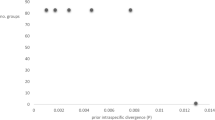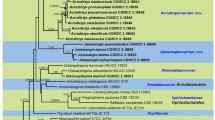Abstract
An unusual Rhodotorula isolated from decayed wood of Nothofagus obliqua (Mirb.) Blume is described and illustrated. This species differs from all accepted Rhodotorula species (1–7, 10) to warrant its establishment as a new species, Rhodotorula nothofagi sp. nov.
Similar content being viewed by others
References
Barnett, J. A., R. W. Payne & D. Yarrow, 1979. A guide to identifying and classifying yeasts. Cambridge University Press, Cambridge, p. 315.
Hagler, A. N. & D. G. Ahearn, 1981. Rapid diazonium blue test to detect basidiomycetous yeasts. Int. J. Syst. Bacteriol. 31: 204–208.
Phaff, H. J. & D. G. Ahearn, 1970. The genus Rhodotorula Harrison. In: J. Lodder (ed.), The Yeasts, a taxonomic study. North-Holland Pub. Co., Amsterdam, pp. 187–1223.
Ramírez, C. & A. González, 1983. New species of yeasts isolated from ‘palo podrido’ in the rainy Valdivian forest. IX International Specialized Symposium on Yeasts. Smolenice, Czechoslovakia, Abstracts I: 25–26.
Ramírez, C., A. González & C. Gutierrez, 1981. Rhodotorula matritense sp. nov., isolated from powdered red pepper (Capsicum frutescens L.). Mycopathologia 74: 173–175.
Ramírez, C. & A. González, 1984. Rhodotorula grinbergsii sp. nov., isolated from decayed wood in the evergreen rainy Valdivian forest of southern Chile. Mycopathologia (in press).
Shivas, R. G. & L. Rodriguez de Miranda, 1983. Two new species of the genus Sporobolomyces and a new Rhodotorula species from leaf surfaces. Antonie van Leeuwenhoek 49: 159–166.
Van der Walt, J. P., 1970. Criteria and Methods used in classification. In: J. Lodder (ed.), The Yeasts, a taxonomic study. North-Holland Pub. Co., Amsterdam, pp. 34–113.
Van der Walt, J. P. & V. K. Hopsu-Havu, 1976. A colour reaction for the differentiation of ascomycetous and hemibasidiomycetous yeasts. Antonie van Leeuwenhoek 42: 157–163.
Yamada, Y. & K. Komagata, 1983. Rhodotorula hasegawae sp. nov., a new asporogenous yeast species. J. Gen. Appl. Microbiol. 29: 323–326.
Zadrazil, F., J. Grinbergs & A. González, 1982. ‘Palo podrido’ — Decomposed wood used as feed. Eur. J. Appl. Microbiol. Biotechnol. 15: 167-¯171.
Author information
Authors and Affiliations
Additional information
Postgraduate student from the Instituto de Ecología y de Evolución, Universidad Austral de Chile, Valdivia.
Rights and permissions
About this article
Cite this article
Ramírez, C., González, A. Rhodotorula nothofagi sp. nov., isolated from decayed wood in the evergreen rainy Valdivian forest of southern Chile. Mycopathologia 91, 171–173 (1985). https://doi.org/10.1007/BF00446296
Issue Date:
DOI: https://doi.org/10.1007/BF00446296




